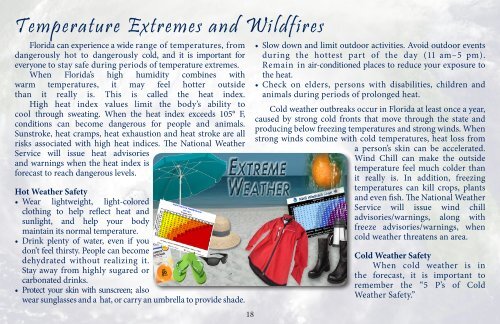2015 Guide
2015 Guide
2015 Guide
You also want an ePaper? Increase the reach of your titles
YUMPU automatically turns print PDFs into web optimized ePapers that Google loves.
Temperature Extremes and Wildfires<br />
Florida can experience a wide range of temperatures, from<br />
dangerously hot to dangerously cold, and it is important for<br />
everyone to stay safe during periods of temperature extremes.<br />
When Florida’s high humidity combines with<br />
warm temperatures, it may feel hotter outside<br />
than it really is. This is called the heat index.<br />
High heat index values limit the body’s ability to<br />
cool through sweating. When the heat index exceeds 105° F,<br />
conditions can become dangerous for people and animals.<br />
Sunstroke, heat cramps, heat exhaustion and heat stroke are all<br />
risks associated with high heat indices. The National Weather<br />
Service will issue heat advisories<br />
and warnings when the heat index is<br />
forecast to reach dangerous levels.<br />
Hot Weather Safety<br />
• Wear lightweight, light-colored<br />
clothing to help reflect heat and<br />
sunlight, and help your body<br />
maintain its normal temperature.<br />
• Drink plenty of water, even if you<br />
don’t feel thirsty. People can become<br />
dehydrated without realizing it.<br />
Stay away from highly sugared or<br />
carbonated drinks.<br />
• Protect your skin with sunscreen; also<br />
wear sunglasses and a hat, or carry an umbrella to provide shade.<br />
18<br />
• Slow down and limit outdoor activities. Avoid outdoor events<br />
during the hottest part of the day (11 am–5 pm).<br />
Remain in air-conditioned places to reduce your exposure to<br />
the heat.<br />
• Check on elders, persons with disabilities, children and<br />
animals during periods of prolonged heat.<br />
Cold weather outbreaks occur in Florida at least once a year,<br />
caused by strong cold fronts that move through the state and<br />
producing below freezing temperatures and strong winds. When<br />
strong winds combine with cold temperatures, heat loss from<br />
a person’s skin can be accelerated.<br />
Wind Chill can make the outside<br />
temperature feel much colder than<br />
it really is. In addition, freezing<br />
temperatures can kill crops, plants<br />
and even fish. The National Weather<br />
Service will issue wind chill<br />
advisories/warnings, along with<br />
freeze advisories/warnings, when<br />
cold weather threatens an area.<br />
Cold Weather Safety<br />
When cold weather is in<br />
the forecast, it is important to<br />
remember the “5 P’s of Cold<br />
Weather Safety.”


